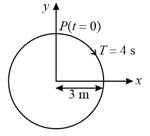EASY
Earn 100
The circular motion of a particle with constant speed is
(a)Simple harmonic but not periodic
(b)Periodic and simple harmonic
(c)Neither periodic nor simple harmonic
(d)Periodic but not simple harmonic
50% studentsanswered this correctly
Important Questions on Simple Harmonic Motion
EASY
EASY

-projection of the radius vector of rotating particle is
EASY
A body of mass is executing simple harmonic motion. Its displacement at seconds is given by . Its maximum kinetic energy is
EASY
EASY
EASY
EASY
Which one of the following graph shows correctly the variation with ?
EASY
EASY
EASY
EASY
EASY
EASY
EASY
EASY
EASY
EASY
EASY
EASY
EASY

